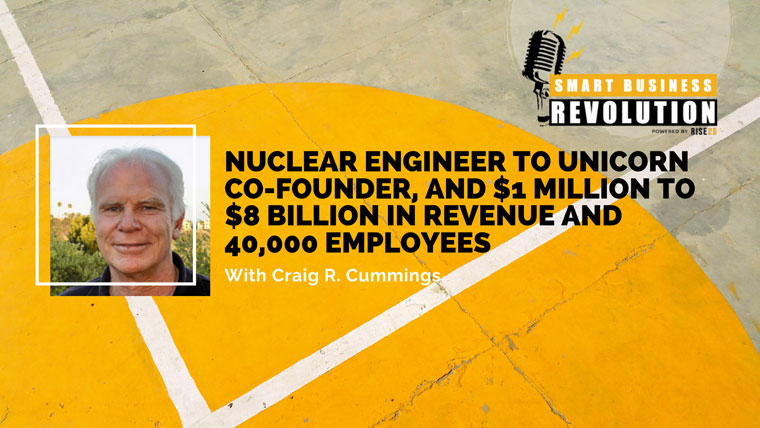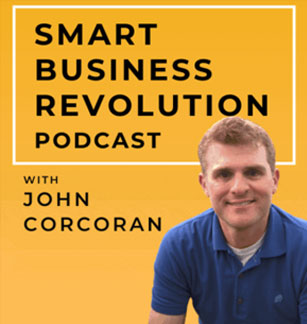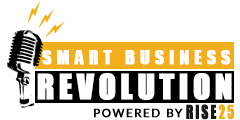

Craig Cummings is a Co-founder and investor at Santa Barbara Angel Alliance. He has founded or co-founded several technology-driven startup companies that executed multi-billion dollar IPO’s (known as “unicorns”) and one that was acquired for $650 million.
Craig has served as a Trustee for both the UC Santa Barbara Foundation and the Vietnam Veterans Memorial Fund. He previously served on the advisory boards of the Eco-Entrepreneurship Program at the Bren School and the Technology Management Program, both at UC Santa Barbara. He is a member of Tech Coast Angels and is the past Chairman of the Central Coast chapter of the MIT Enterprise Forum. Craig holds nuclear engineering degrees from UC Santa Barbara and MIT.
Craig Cummings, a Co-founder and investor at Santa Barbara Angel Alliance, is John Corcoran’s guest in this episode of the Smart Business Revolution Podcast, where they talk about Craig’s experience working at SAIC under Bob Beyster’s leadership and what he learned from the experience. They also talk about investing in startups, the benefits of an angel alliance, and what led to the collapse of SpectraFluidics. Stay tuned.
Here’s a Glimpse of What You’ll Hear:
- How Bob Beyster, the Founder of SAIC, impacted Craig Cummings’ life
- How Craig’s role evolved while working at SAIC
- Craig talks about using technology to improve toll collection services and to help with the coordination, tracking, and accounting for rail cars and freight containers
- The reasons behind the founding of Leidos and how Bob Beyster was removed from the management of SAIC
- Would Craig have invested in a consulting company similar to SAIC?
- What is an angel alliance, and what are its benefits?
- How Craig evaluates investing in companies and founders
- Craig talks about investing in Apeel Sciences, how he knows when to step in and help companies he has invested in and shares the story behind the collapse of SpectraFluidics
- Craig’s experience teaching entrepreneurship at UC Santa Barbara
- Craig talks about the peers he respects and how to get in touch with him
Resources Mentioned In This Episode
- SAIC
- Craig R. Cummings’ website
- Craig R. Cummings on LinkedIn
- Matt Stock on LinkedIn
- Karen Ravago-Ballaret on LinkedIn
- Leidos
- Apeel Sciences
- James Rogers on LinkedIn
- Jason Spievak on LinkedIn
- “[Top UCSB Entrepreneur Series] Growing Multiple Billion-Dollar Companies and Solving the Global Food Poverty” with Jason Spievak
- John Greathouse on LinkedIn
- “[Top UCSB Entrepreneur Series] From GoToMeeting to VC to Professor of Entrepreneurship” with John Greathouse
- John Petote on LinkedIn
- Santa Barbara Angel Alliance
- CIO Solutions
Sponsor: Rise25
At Rise25, we’re committed to helping you connect with your Dream 100 referral partners, clients, and strategic partners through our done-for-you podcast solution.
We’re a professional podcast production agency that makes creating a podcast effortless. Since 2009, our proven system has helped thousands of B2B businesses build strong relationships with referral partners, clients, and audiences without doing the hard work.
What do you need to start a podcast?
When you use our proven system, all you need is an idea and a voice. We handle the strategy, production, and distribution – you just need to show up and talk.
The Rise25 podcasting solution is designed to help you build a profitable podcast. This requires a specific strategy, and we’ve got that down pat. We focus on making sure you have a direct path to ROI, which is the most important component. Plus, our podcast production company takes any heavy lifting of production and distribution off your plate.
We make distribution easy
We’ll distribute each episode across more than 11 unique channels, including iTunes, Spotify, and Google Podcasts. We’ll also create copy for each episode and promote your show across social media.
Cofounders Dr. Jeremy Weisz and John Corcoran credit podcasting as being the best thing they have ever done for their businesses. Podcasting connected them with the founders/CEOs of P90x, Atari, Einstein Bagels, Mattel, Rx Bars, YPO, EO, Lending Tree, Freshdesk, and many more.
The relationships you form through podcasting run deep. Jeremy and John became business partners through podcasting. They have even gone on family vacations and attended weddings of guests who have been on the podcast.
Podcast production has a lot of moving parts and is a big commitment on our end; we only want to work with people who are committed to their business and to cultivating amazing relationships.
Are you considering launching a podcast to acquire partnerships, clients, and referrals? Would you like to work with a podcast agency that wants you to win?
Contact us now at [email protected] or book a call at rise25.com/bookcall.
Rise25 Cofounders, Dr. Jeremy Weisz and John Corcoran, have been podcasting and advising about podcasting since 2008.
Episode Transcript
Intro 0:01
Welcome to the revolution, the Smart Business Revolution Podcast where we ask today’s most successful entrepreneurs to share the tools and strategies they use to build relationships and connections to grow their revenue. Now, your host for the revolution, John Corcoran.
John Corcoran 0:40
All right. Welcome, everyone. John Corcoran here, I’m the host of this show, and I feel so privileged every week to have great conversations with CEOs, founders and entrepreneurs of all kinds of different companies, ranging from Netflix, YPO, EO, Activision Blizzard, Lending Tree, Open Table, Ace Software, go check out my archives, you’ll see some great episodes there. I’m also the Co-founder of Rise25, where we help connect b2b business owners to their ideal prospects. And before I introduce today’s guests, I want to give a quick shout out and thank you to Matt Stock and Karen Ravago-Ballaret at UC Santa Barbara who’s helping to put together this series profiling some top UC Santa Barbara entrepreneurs and founders.
And my guest is kind of funny. His introduction sounds a little bit like a knock knock joke. He’s a Gaucho. He’s a nuclear engineer. And he’s a unicorn or at least a unicorn founder. He’s founded or co-founded several technology driven startup companies that executed multibillion dollar IPOs, including one, which he wrote, that really contributed to under a million dollars to $8 billion, just truly phenomenal. We’re going to talk about that in a second. Another one that was acquired for around $650 million. He has also served as a trustee for the UC Santa Barbara Foundation and the Vietnam Veterans Memorial Fund, and also has served on a number of different advisory boards affiliated with UC Santa Barbara. And he’s also a member of the Tech Coast Angels and Santa Barbara Angel Alliance and past chairman of the Central Coast chapter of the MIT Enterprise Forum.
And of course, this episode is brought to you by Rise25 Media, where we help b2b businesses to get clients, referrals and strategic partnerships with podcasts and content marketing. And if you are curious about doing a podcast, I’m an evangelist. I told everyone for the last 11 years that they should do a podcast. So if you’re curious, email us at support@rise25media, or you can check out our website rise25.com. All right, Craig, it’s such a pleasure to have you here today. And, you know, I want to ask you about this rocket ship ride that you went on over the course of about 25 years. You join this little startup company that was doing some consulting work advising the Navy on government contracting, stuff like that under a million dollars in revenue. It’s called SAIC, a publicly traded company now took it from however many a couple dozen, maybe 100 employees under a million in revenue to $8 billion 40,000 employees 200 or so offices? Wouldn’t be crazy. What a crazy ride that must have been. But it starts with Bob Beyster, I think was his name. Bob Beyster, the CEO and Founder, talks a little bit about Bob, because I know he has a big influence on your life.
Craig Cummings 3:26
He certainly was really like a second father to me. He’s the one that founded SAIC, and the driving force for him was to have an employee owned company. He really felt almost religiously that those who built the company should own the company and not outsiders. And that may not sound terribly unique today, but it was highly unique at the time, and nearly 70s, mid 70s. And it turned out to be an incredible formula, really.
John Corcoran 4:04
And it made a lot of people, a lot of money. A lot of them made a lot of millionaires.
Craig Cummings 4:09
If I think you mentioned this, but at the end of the end of my time, the company was about a billion dollars in revenue. And the largest shareholder was at that time the CEO, Bob Beyster. And he owned less well under 2% of their company barely 1%. And the rest of it was spread out so that it really was truly an employee owned company. Not just a couple of people at the top
John Corcoran 4:41
and incredibly intelligent people there you were one of the few non PhDs even though you’re no slouch, you had an angry nuclear engineering master’s degree from MIT. But you said you felt a little bit intimidated at times and he gave you some words Wisdom.
Craig Cummings 5:01
Yes, I was intimidated a lot of the time. But when I first showed up, I was really in my group, or the office that I was in there was, I was the only non PhD. And most of these guys had PhDs from, you know, really prestigious schools, not just some, some Podunk place. And most of it was in physics and math, engineering degrees. And again, I was the only non PhD there. And these guys were so brilliant. I showed up and I was also the youngest by about 10 to 15 years. And after a couple of meetings and projects, I said, Man, I’m not going to survive, or these guys are so freaking smart. They’re going to discover that I’m not in that league, and get rid of me. But it got kind of down and a beiser came over more than once, and said, Hey, don’t worry about it. Just Just keep your head down plugging away. You’re doing fine. And I stayed on for 25 plus years after that. So that was an interesting start. Yeah.
John Corcoran 6:09
Now, one of the challenges of growing that dramatically as your role has to change over time. And, you know, you said that you were kind of known as Senior VP of whatever is coming next. So it sounds like you evolved, you oversaw different divisions? What did it take in order to survive and thrive at a company that changed so dramatically from under a million in revenue to 8 billion in revenue? How did you evolve and adapt and move into different roles?
Craig Cummings 6:40
Well, a lot of people don’t. And we had a lot of employees that really were not made for that environment. It’s a very fast paced environment. And you’re absolutely right, your job was changing very rapidly, frequently. And it’s a personality sort of thing. And for me, that was a perfect recipe, I have a short attention span. And, you know, once a project is sort of mastered, or you know, we can figure it out. For me, anyway, it gets boring after that, I didn’t want to go into something else. And so it was, it was absolutely the greatest job. If I had to write out a job description, I couldn’t have done better than or, you know, had a better job than when I did have, it was really, really fantastic. I’m kind of a geek, you know, at heart. So I worked on all kinds of technologies, I mean, really amazing stuff. And most of it, I didn’t know anything about when I started, but it was really interesting. So I had no problem reading up and, and learning and, and,
John Corcoran 7:43
and one of the things that was interesting about what you did is you were taking new technologies and adapting them to non traditional old school, non sexy industries, like railroads and toll collection places like talking about the toll collection example. Because that’s one where you have, you know, or you did have low wage workers, collecting coins, there’s issues with, you know, theft and accuracy, all that kind of stuff. So talk a little bit about those experiences.
Craig Cummings 8:13
Yeah, in total rows are much more common in the east, and then they are here in the West. So for those of you born and raised in California, or the Northwest, you probably haven’t seen that many toll toll roads or toll bridges, but they’re very prevalent in East and the traditional way these things were organized was no, you seen the toll booth and come in, and you give the guy a quarter, sometimes two quarters, I don’t know what whatever it is, sometimes it’s $1. Many times you wait for change, you have an automatic coin machine where sometimes you can throw it into the basket and hopefully be corrected, counted correctly. But it was a situation where actually it’s an awful lot of money, if you go through the math it is a phenomenal amount of money. And it’s in the hands of minimum wage employees it is and this is just not a very good situation. There is no real inherent accounting of it in the sense of zeroing out at the end of the day, let’s say you’re at the end of a shift. So there was a lot of profit sharing going on with the toll collectors. And our system was totally electronic today, it would not be considered that that you need but we were the first ones to build a totally electronic system. And it also was a free flow system. In other words, you didn’t have to stop at the Tollway. If it was equipped properly. You just drive right on through and Nowadays most of them don’t even have a toll booth at all. You just drive right through like right, right for some of those. And so it was tremendously successful. And it was kind of hard for some people to get used to it.
John Corcoran 9:57
But yeah, anytime you have an old school industry where it requires a lot of change. Was that a hard sell going to these bridge districts and counties and highway districts? And trying to sell them on this new solution?
Craig Cummings 10:11
No, not really. I think it probably was, but I didn’t see it as much. I would always end up talking to their engineer, and he would get it. And so it’d be up to him to sell it within his group to Hey, this makes sense. And it really did. There’s no question it was financially the right thing to do. It’s good for the drivers, because they don’t have to stop less congestion, you don’t have to have a bunch of money with you all the time. Yeah, it’s just like anything, any other account yourself on account or whatever, you get it once a month. And you look and yeah, that’s me. And, yeah, I probably took those trips. And that’s it, you know, so it was not as hard as you might think. Yeah.
John Corcoran 10:55
Now, another project you worked on, it’s amazing to think of it these days. These days, we all have a smartphone in our pocket. And there’s Uber and things like that, which allows, you know, underutilized assets to communicate and coordinate different rides and transportation, that sort of thing. But you took on the freight industry, the rail industry, and at the time, there were hundreds of 1000s of train cars around the US, many of which weren’t really accounted for.








